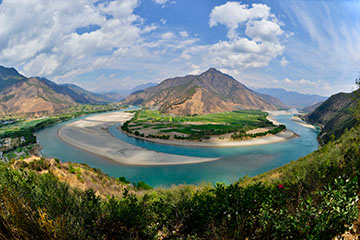Name in Chinese: 中甸 Zhōng Diàn [dzɔ:ŋdiæ]
Location: Northwestern Yunnan, China, GMT+8
Population: 178,000 as a county, about 66,000 living in the town
Telephone Code: +86887
Keywords: Potatso National Park, Sumtsenling Monastery and the Tiger Leaping Gorge
There are two towns named as Shangri-La in China. One is a county in Diqing Tibetan Autonomous Prefecture, Yunnan Province. The other one is a township in Garze Tibetan Autonomous Prefecture, Sichuan Province. People often confuse Yunnan’s Shangri-La with Sichuan’s Shangri-La. Yunnan’s Shangri-La was called Zhongdian and renamed in 2001, while Sichuan’s Shangri-La was known as Riwa Town and given the new name in 2002. Both are very beautiful places in the Grand Shangri-La Zone. The Grand Shangrila Zone refers to the border region between China’s southwestern provinces, namely Sichuan, Tibet and Yunnan. Sichuan’s Shangri-La is famed for Daocheng Yading Nature Reserve which is well-known as the Last Pure Land on the Blue Planet. Click here to read more about the Authentic Shangri-La.
This article focuses on sightseeing resource of Yunnan’s Shangri-La City(or Zhongdian County). The City of Shangri-La is the capital of Diqing Prefecture. It lies in the southeast part of Qinghai-Tibet High Plateau. Its altitude ranges from 1,503meters (4,931 feet) to 5,545 meters(18,192 feet) above sea level. The county is mainly inhabited by the Khampa Tibetans. Local Khampa Tibetans claim that the word Shangri-La is derived from their word for paradise, “Shambala”. Shangri-La is a fictional place in the novel Lost Horizon composed by James Hilton, a British author. It has become synonymous with any earthly paradise and Himalayan utopia. The novel Last Horizon was composed in 1933, inspired by the scientific investigation carried out by Joseph Rock. Shangri-La County is rich in sightseeing resources. It attracts visitors with its gorgeous landscape and unique Tibetan culture.
Attractions:
Potatso National Park
Potatso National Park lies about 24 kilometers(15 miles) to the east of downtown Zhongdian. It is noted as the First National Park of China. The park is a component of the Three Parallel Rivers Heritage Site, is a national five-star scenic area. Shudu Lake is the highlight of the park. It measures 15 square kilometers(5.8 sq.mi). It gives the impression of the authentic Shangri-La.
Ganden Sumtsenling Monastery
Ganden Sumtsenling Monastery is located in the northern suburb of Zhongdian, about five kilometers(3 miles) to the center of the city proper. It is also called Songzanlin Monastery by the locals, is the largest lamasery in Yunnan Province. The monastery was founded in 1679, and named as Ganden Sumtsenling Monastery by the Fifth Dalai Lama. Well-known as the Twin Sister of of Potala Palace, Ganden Sumtsenling Monastery belongs to the Ge-lug-pa Sect of Lamaism.
Dukezong Ancient Town
Dukezong Ancient Town covers an area of 160 hectares(395 acres). It was founded in the late seventh century. At that time, Tibetan people constructed a castle on the Tortoise Hill and named it as Dukezong. Gradually, more and more Tibetans built their houses by the castle. The old town shows the typical Tibetan styled architecture. The Tortoise Hill is a beautiful park overlooking the old Tibetan Town. There is a huge prayer wheel placed in the park. It is the landmark of Zhongdian.
The Tiger Leaping Gorge
The Tiger Leaping Gorge is a component of the Three Parallel Rivers, a world natural heritage site. It lies between the Jade-Dragon Snow-capped Mountain and Haba Mountain, about 80 kilometers(50 miles) to the north of downtown Lijiang. It is one of the deepest canyons in the world with a maximum depth of over 3,900 meters(12,795 feet) and a total length of 17 kilometers(10.6 miles). The visitors are stunned by the spectacular scenery of the gorge.
Climate
Shangri-La County has complex and divers weather conditions due to the big difference of elevation. The high mountains have a cold climate, while the valleys and river basins keep a temperate climate through out the year. The average temperature in Shangri-La ranges from minus 6℃(21.2°F) to 7℃(62.6°F) in spring, 5℃(55.4°F) to 15℃(75.2°F) in summer, 9℃(59°F) to 18℃(75.2°F) in autumn, minus 4℃(24.8°F) to 10℃(66.2°F) in winter. The best time to travel to Shangri-La County is between May and October.
How to Get to Shangri-La
Diqing Shangri-La Airport is located in the south part of downtown Shangri-La. It operates flights to 6 domestic cities within Mainland China, namely, Chengdu, Lhasa, Guangzhou, Shenzhen, Kunming and Xishuangbanna. The distance between Shangri-La and Lijiang is 176 kilometers(109 miles). The tourists usually travel to Shangri-La from Lijiang by car, due to the difference of elevation between the two cities.
How to Avoid Acute Mountain Sickness
The City of Shangri-La is at an elevation of 3,280 meters(10,761 feet) above sea level. Some attractions in the county are higher than the city. The tourists might suffer from the Acute Mountain Sickness(AMS). Tips for you to prevent the AMS include keeping hydrated, avoiding a cold, acclimatizing to altitude gradually, avoiding rapid ascent and strenuous exercise, restraining from smoking and drinking alcohol.
Author: Tina Luo
Update:

